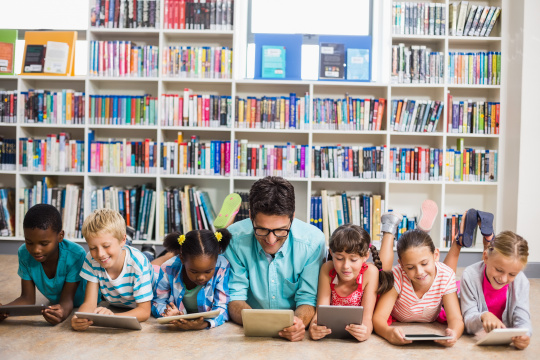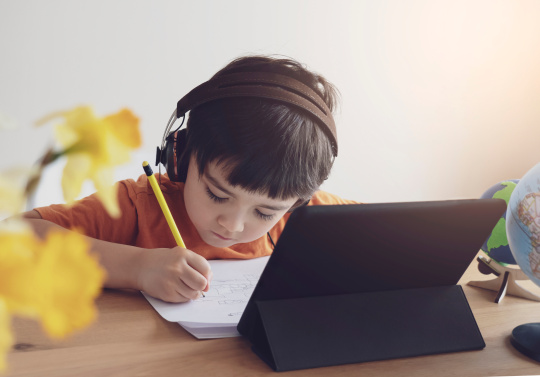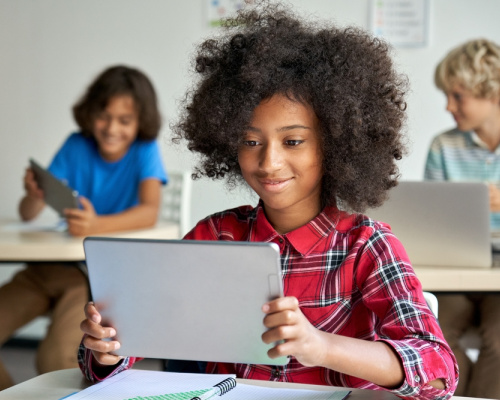Revitalizing Literacy: Aligning Products to the Science of Reading
Date
With today’s increasing use of digital tools, learners need to understand how to utilize technology to become productive and critical readers, writers, and presenters of ideas.
According to the National Assessment of Educational Progress (NAEP), average reading scores for 13-year-olds have declined by 4 points compared to the 2019-2020 school year, and by 7 points compared to a decade ago. This data highlights the urgency for innovative solutions that enhance student literacy development.
From devices to digital curricula and tools with embedded AI-features, there is no shortage of solutions to support student literacy. In fact, per a 2023 report from Project Tomorrow, 91% of K-12 educators report that their learners have access to a personally assigned digital learning device within the classroom, three times that of 2014. The report also indicates that 50% of educators now say they are comfortable leveraging these devices in their learning activities while less than half noted this comfortability in 2018.
With greater access and comfort using digital devices for learning, ESSER funding coming to an end, and an overwhelming number of literacy tools available to educators, school districts are looking for sustainable and comprehensive solutions that effectively support the growing literacy needs of learners. Today’s classrooms emphasize the need for more active learning and personalization to ensure that all learners are literate.
Understanding the Science of Reading and How Literacy Develops
To effectively address today’s literacy challenges, it’s imperative to understand the science of reading and the components of literacy development. The science of reading consists of scientifically-based research about literacy that informs how proficient reading and writing develop, why learners struggle, and how to effectively teach and assess it.
The science of reading promotes teaching the foundations of language, like phonological awareness and decoding, in a structured progression while building language comprehension skills, like language structures, vocabulary, and background knowledge. Each stage is critical to learners’ ability to read and write and build on their word recognition and language comprehension to develop reading comprehension over time. Learn more about each stage of language development.
Enhancing Literacy Development with Digital Solutions

School decision-makers are seeking to improve student learning experiences for all and are looking for your product and resources guided by the science of reading. Technology can be part of an effective literacy solution when embedded strategically within cohesive, evidence-based instruction that actively engages learners. Consider these active learning and engagement strategies to enhance your product to help develop learners’ literacy skills.
Active Learning
Learning tools should allow learners to engage with content in multiple ways rather than passively consuming it to enhance comprehension and retention. This may include opportunities for learners to select words to hear the pronunciation or definition or interactive quizzes that assess comprehension. It’s important that these features offer real-time feedback to allow learners to grow.
- Collaborative Experiences: Word processing applications like Google Docs or Microsoft Word facilitate collaborative writing and authentic feedback.
- Annotation Features: Tools, such as Adobe Acrobat and Kami, offer opportunities for learners to annotate with text highlighting, digital sticky notes, and drawing tools to enhance their experience. This may look like marking unfamiliar words, finding rhyme patterns, or identifying text evidence.
- Checks for Understanding: It’s important to check for student understanding of text and/or skills frequently taught. Consider how learners with varied preferences and accessibility needs may best show their comprehension, fluency, and phonics skills through audio and video assessments, using tools like Flip and EdPuzzle.
- Opportunities for Reflection: Create spaces for learners to reflect on their learning, set goals, and monitor their progress. Adding features like digital journals or reflection prompts, such as those found in Pear Deck or Seesaw, within your product can encourage increased metacognition and self-regulation, enabling learners to take ownership of their progress.
Engagement and Choice

Literacy solutions should increase student engagement and offer diverse ways to demonstrate comprehension, such as book talks, movie clips, and group projects. Consider expanding your product’s features to provide learners with more choices in how they showcase their understanding and engage in learning.
- Audio-Visual Elements: Incorporating audio-visual elements can help students interpret and engage with comprehension skills and vocabulary in different ways to support further skill development. Consider adding short vignettes or audio-visual resources like Pixar shorts that are aligned to literacy skills, such as analyzing plot and setting, making inferences, and evaluating theme. This provides educators with a rich set of resources that help learners practice using skills prior to interpreting and analyzing text.
- Accessible Texts: Learners must have access to grade-level text as well as text that is at or slightly above their reading level in order to progress their skills. As all learners enter the classroom at different levels, consider developing features in your product that allow learners to access a range of texts. Platforms like Epic Books and Raz-Kids allow learners to choose from a variety of digital books at a level deemed appropriate by their parent or educational staff, allowing them to read independently and maintain their reading habits.
- Game-Based Learning: Gamified tools can reinforce literacy skills, including vocabulary, spelling, grammar, and phonics, providing immediate feedback to individual learners and increasing engagement. These elements don’t need to be complex and can be as simple as asking learners to listen to a sound (phoneme) and match it to the corresponding letter (grapheme) to practice phonological awareness.
- Explicit Modeling: To support blended learning classrooms, literacy products should offer resources and guidance to educators that show learners how to effectively use and interact with the tool. Just offering a learner access to a program is not enough to impact learning outcomes. Developing comprehensive materials for educators, as well as on-demand support features for learners, is necessary to ensure successful implementation and use of your product.
With significant disruptions to learners’ literacy development, it’s become increasingly important to ensure that the digital tools educators use leverage the science of reading. We can help you create innovative solutions and materials that support literacy development at all stages with opportunities for active learning and student engagement. Contact Clarity to learn more about how we can help your product make a difference.
The Stages of Language Development
- Pre-Reading (Birth-Kindergarten): This stage focuses on developing essential foundational skills, including print awareness, oral language development, phonemic awareness, letter recognition, and early writing. This is when a child recognizes that books are read from left to right and from top to bottom and begins to identify that the sounds of individual letters make up words.
- Initial Reading or Decoding (Grades 1-2): During this period, learners develop the fundamentals of reading, such as phonics, sight words, basic reading comprehension, and early fluency. They begin to engage in vocabulary development and emerge as beginning writers. Learners in this stage begin to understand how letter-sound relationships work to help them decode and read words and start to understand the meaning of simple texts and answer questions about what they’ve read.
- Transitional Reading (Grades 3-4): Learners in this stage refine their skills by improving fluency, implementing comprehension strategies, expanding their vocabulary, and exploring various text genres. They will also further develop their writing skills and begin reading for different purposes. This is one of the most challenging stages for many readers as they move from learning to read to reading to learn by using strategies to help them predict, summarize, and make connections to texts.
- Intermediate Reading (Grades 4-6): This stage introduces more complex reading comprehension and text analysis. There is also an emphasis on improved reading stamina and enhanced writing skills. Learners in this stage use diverse reading materials with deeper meanings and complex structures to think more critically about text to form their own opinions and interpretations.
- Advanced Reading (Grades 6+): Learners at this stage focus on deeper comprehension while making connections between different texts and forming complex arguments. They critically evaluate texts to assess credibility and evaluate the author’s intentions. In this stage, learners also expand their vocabulary, read for various purposes, and hone their writing skills

